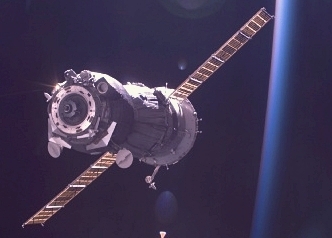
 |
![]() Image choisie: Un Soyouz quitte la Station Spatiale Internationale
Image choisie: Un Soyouz quitte la Station Spatiale Internationale
L'équipage Expédition 10 quitte la Station Spatiale Internationale (SSI) à bord d'un Soyouz russe (24 avril 2005). Ce sont des Soyouz russes qui, depuis la perte de la navette américaine Columbia en février 2003, assurent les liaisons avec la SSI. Le nombre des membres d'équipage, depuis lors, a été restreint à 2 et les équipages rejoignent la station puis reviennent sur Terre à bord d'un Soyouz. C'est la navette spatiale qui assurait les voyages jusque là et elle était de plus capable de transporter du fret en volume important. La Station Spatiale Internationale est un partenariat de 16 pays (Etats-Unis, Canada, 11 pays de l'Union Européenne, Japon, Russie et Brésil) qui vise à installer, à bord de la station, en orbite terrestre basse, 6 laboratoires spatiaux. La station spatiale connaît maintenant un renouvellement de ses buts dans la mesure où elle est incorporée au service du nouveau programme spatial américain connu sous le nom de "Vison for Space Exploration". Ce programme va ramener l'homme sur la Lune puis l'emmener sur Mars. La Station Spatiale Internationale servira désormais à étudier les questions liées aux séjours de longue durée dans l'espace. La station spatiale orbite à une altitude de 350-370 km (230-218 miles), avec une inclinaison de 52° sur l'équateur. image NASA